B2B lead generation strategies in 2026 looks drastically different than just a year ago. Artificial intelligence is transforming how businesses find prospects, while buyers now self-educate and delay contact with sales. If you’re still relying on outdated methods, expect lower returns.
In this guide, we’ll cover the top B2B lead generation strategies (and best practices) that successful companies are using right now. From leveraging AI tools and content marketing to optimizing emails, SEO, and even partnering with lead marketplaces. You’ll learn proven tactics to fill your pipeline with high-quality leads.
Read on for 10 effective B2B lead generation tactics to attract and convert more B2B prospects in 2026. Let’s dive in!
Related: What is B2B Lead Generation? How It Works and Why It Matters
Why B2B Lead Generation Strategies Matter
Before diving into the strategies, let’s go over the importance of having a lead-generation strategy in the first place. So, why do you need to create a B2B lead generation strategy? Well, for one, to succeed. Strategies are a vital component of any business’s roadmap to success. The strategies you put in place provide a structure for achieving your goals. Simply put, they help you focus on what needs to be executed and when throughout the year. With the correct strategies in place, you can connect with potential customers interested in your product or services
Ultimately, having a good B2B lead generation strategy in place isn’t just a choice, it’s a necessity. Why? Here are some compelling reasons:
- Continuous Growth: Without an effective lead generation strategy, your business may struggle to maintain its customer base, let alone expand it.
- Cost Efficiency: Lead generation strategies, when executed effectively, help you optimize your spending by concentrating on leads with the highest potential for conversion.
- Data-Driven Decision-Making: Lead generation strategies generate valuable data and insights. You can track which tactics are working, understand your audience better, and adjust your approach accordingly.
The key to success in 2026 and beyond is having well-crafted B2B lead generation strategies.
10 Effective B2B Lead Generation Strategies for 2026
Generating high-quality leads has never been more challenging, or more important. In 2026, B2B buyers are researching longer, expecting faster answers, and relying heavily on digital interactions before ever talking to sales. Add in Google’s AI Overview changing search visibility, and traditional tactics alone won’t cut it anymore. To stay competitive, businesses need to rethink how they attract, engage, and convert leads.
The good news? There are proven strategies you can use right now. Below, we’ll break down 10 effective B2B lead generation strategies for 2026. From leveraging AI to optimizing your website, so you can fill your pipeline with qualified leads and close more deals.
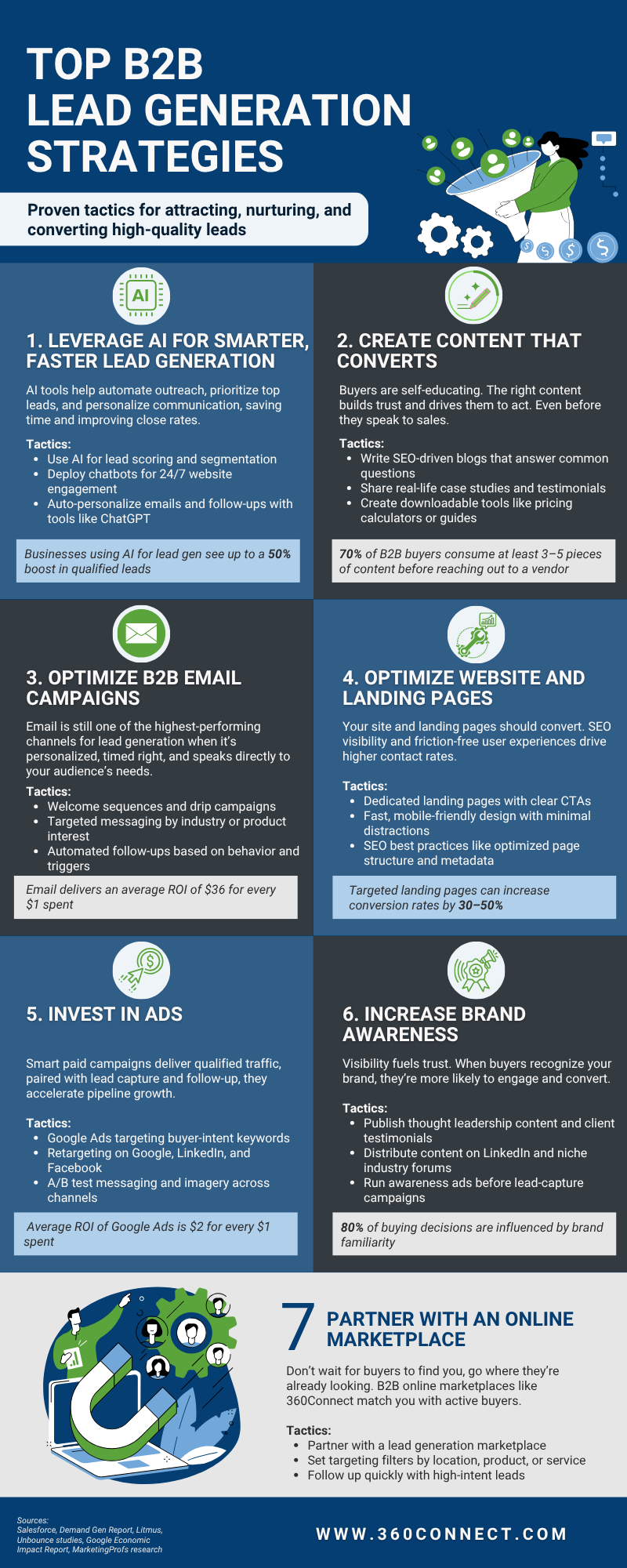
1. Leverage AI Tools for Smarter B2B Lead Generation Strategies
AI is changing the way B2B businesses generate leads, and fast. From automated prospecting to real-time engagement tools, artificial intelligence is becoming a must-have for companies looking to save time, scale faster, and connect with the right buyers. If you’re still doing everything manually, you’re likely leaving leads (and money) on the table.
Let’s break down how AI can actually support your lead generation strategy.
How B2B Businesses Are Using AI for B2B Lead Generation Strategies
AI is no longer a futuristic concept. It’s being used every day to help sales and marketing teams get in front of better leads, faster. Here’s what that looks like in practice:
Predictive Lead Scoring
AI can automatically analyze your existing data and tell you which leads are most likely to convert, so you can focus your time where it counts.
Chatbot Lead Qualification
Chatbots and virtual agents can qualify leads 24/7, book meetings, and answer FAQs without needing a human to step in.
AI-Powered Email Personalization
AI-powered writing tools can help you create tailored emails and messages based on industry, behavior, or buyer intent.
Automated Prospecting and Enrichment
Tools like Apollo.io or Cognism can fill your pipeline with updated, accurate lead data, no more hours spent manually hunting down contacts.
All of this leads to faster response times, stronger conversion rates, and more predictable sales pipelines.
Related: How to Use AI for Lead Generation
How to Optimize for Google AI Overview
You may have noticed that Google is changing too. Its new AI Overview feature often answers users’ questions at the top of search results, without requiring a click. That means if your company relies on organic traffic to generate leads, AI Overviews could be cutting into your visibility.
So, what can you do?
- Double down on clarity: AI Overviews often pull from pages that answer questions clearly and directly. Make sure your content is well-structured and answers search queries head-on.
- Add helpful visuals, charts, and data: Google tends to favor pages that are rich in useful information. Include things like comparison tables, pricing breakdowns, or expert tips.
- Focus on topics that position your business as a solution: Even if searchers don’t click, being listed in an AI Overview means your brand is seen as a trustworthy source.
AI isn’t just shaping how leads are generated. It’s also shaping how people find your business. Adjusting your strategy to account for both sides of the AI shift will help you stay ahead.
Quick Tips to Start Using AI in Your Lead Strategy:
- Use a chatbot to pre-qualify site visitors and capture contact info.
- Try AI-powered email tools to personalize and test outreach.
- Explore platforms that offer intent data or predictive scoring.
- Monitor your performance regularly, AI tools still need human direction.

Chatbots
Chatbots provide instant responses to customer queries, collect information, and guide leads to relevant resources. They enhance user experience and capture leads 24/7, improving engagement and efficiency.

ChatGPT
ChatGPT, an advanced AI chatbot, offers natural language communication and can be employed in various customer support and sales conversations.
- Sales Pitch Content
- Emails
- Job Postings
- And More!
2. Create Content that Converts (Quality Content Marketing)
Content isn’t just important in 2026, it’s the backbone of nearly every successful lead generation strategy today. B2B buyers are doing more independent research than ever before, often waiting until the very end of the buyer’s journey to speak with sales. That means your content has to do the heavy lifting early on: attracting the right audience, building trust, and guiding them toward action.
And with Google’s AI Overview pulling answers directly into search results, your content needs to be clear, structured, and genuinely helpful if you want to stay visible.
So, how do you create content that converts? It’s not about pumping out blog posts, it’s about building a strategic content engine that speaks to buyer pain points and positions you as the solution. Here are a few formats that work well in 2026:
2026 B2B Lead Generation Content Strategies:
- Search-optimized blogs and guides that answer buyer questions clearly and directly
- Industry reports that showcase original data, trends, or insights buyers can’t get elsewhere
- Infographics that turn complex information into easy-to-digest, shareable visuals
- Videos and webinars that demonstrate value, explain complex products, or share industry expertise
- Case studies and testimonials that build trust with real-world results
- Downloadable resources like comparison charts, pricing sheets, or ROI calculators
- AI-assisted content that uses tools like ChatGPT or Jasper to scale ideas, personalize messaging, and streamline production
If your content isn’t generating qualified leads, it’s time to revisit your strategy, not just what you’re creating, but how and why you’re creating it. When done right, content does more than educate. It becomes your best salesperson.
Below, we dive into a few suggestions to get you started.
Offer Valuable Industry Reports or Whitepapers
For B2B suppliers, industry reports are an invaluable way to provide helpful information to potential buyers. These comprehensive reports, rich with valuable information, not only establish your authority but also incentivize visitors to provide their contact details in exchange for access. Crafting industry reports that dive deep into trends, challenges, and solutions can be a highly effective way to capture leads and position your business as a thought leader.


Use Visual Content
Infographics are a visual delight in the world of content marketing. In an age where attention spans are fleeting, infographics offer a quick, engaging, and informative way to communicate complex ideas. They simplify data and statistics, making it easy for your audience to digest. By offering valuable insights in a visually appealing format, infographics encourage shares, generate leads, and foster engagement.
In addition, from an SEO standpoint, infographics offer a great deal of value. By adding an “alt tag” to your infographic it can rank as an image alone and drive traffic back to your website.
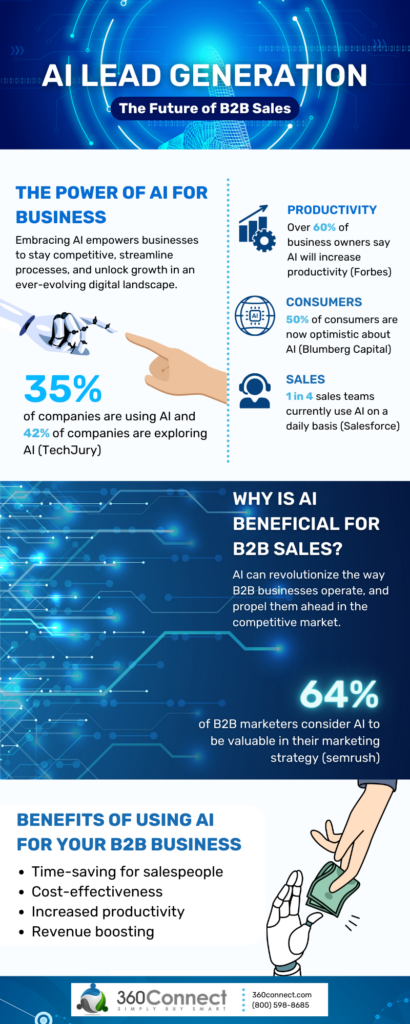
Publish SEO-Optimized Blog Posts & Guides
Blogs are the backbone of a successful content marketing strategy. They allow you to address your audience’s pain points, provide solutions, and share valuable insights. Consistency is key when it comes to blogging, as it builds a reliable source of information for your target audience. With compelling blog content, you can attract potential leads, keep them engaged, and move them closer to conversion by guiding them through the sales funnel. This includes separate strategies for the buyer’s journey through awareness, consideration, and decision.
Related: How To Grow Your Business With Content Marketing
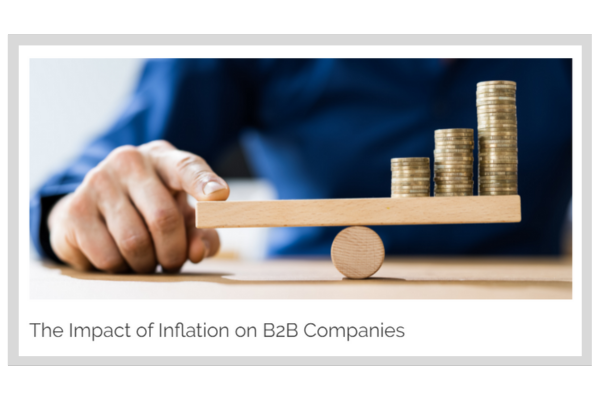

3. Optimize B2B Email Campaigns
Optimizing your email campaigns is a pivotal element of effective B2B lead generation strategies. Emails provide a direct and personal connection to your leads, enabling you to build relationships and guide prospects toward conversion. Below are a few strategies you can use to craft email campaigns that resonate with your audience and drive results.
Personalized Emails
Personalization has evolved from a trend to an expectation in the world of email marketing. Segmenting your email lists, creating tailored messages, and addressing recipients by their names can significantly enhance engagement and conversion rates. Personalized emails make your leads feel valued and understood, increasing the likelihood of them taking the desired actions.
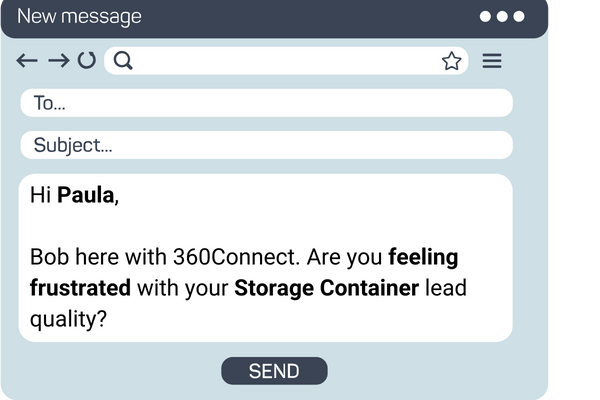
Newsletter Signups
Having a monthly newsletter sent out via email is a great way to engage and convert customers. Newsletters offer a consistent and non-intrusive way to maintain a connection with leads, keep them informed about your offerings, and gently nudge them down the sales funnel. First, you’ll need to create a newsletter sign-up form on your website where prospects/customers can subscribe. Then, create compelling content and email campaigns centered around a monthly Newsletter.
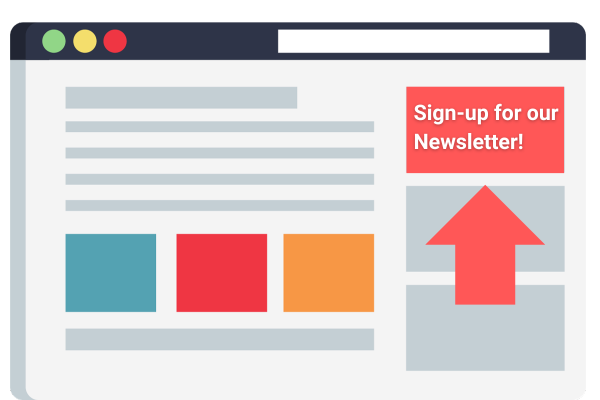
Drip Campaigns
Drip campaigns involve sending a series of automated, pre-planned emails to nurture leads over time. These campaigns are designed to deliver the right message at the right time, keeping leads engaged and moving them closer to conversion. Additionally, Drip campaigns help you stay top-of-mind with your leads and guide them through their decision-making process.

Automation
Marketing automation platforms are a game-changer when it comes to email campaigns. In fact, 80% of marketers think marketing automation generates more leads. Automation streamlines the process of sending targeted and timely emails, ensuring your leads receive relevant content at the right moments in their customer journey. Indeed, by leveraging automation, you can save time, reduce manual labor, and deliver a personalized experience that drives lead conversion.
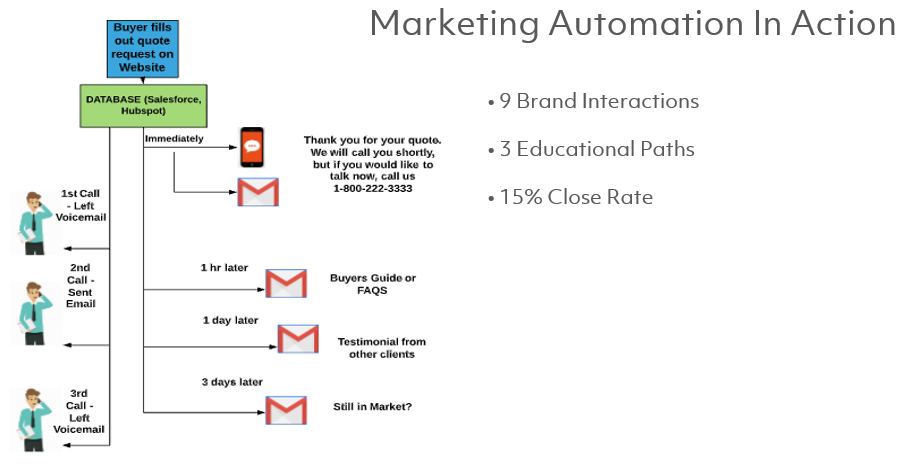
4. Optimize Website and Landing Pages
Your website and landing pages are digital storefronts that directly influence lead generation. Optimizing them for maximum impact is crucial for success. Let’s delve into the strategies that will enhance your website’s appeal to potential leads, making it an effective tool for capturing and nurturing prospects.
Improve On-Site SEO
Search engine optimization (SEO) is the foundation of online visibility. A well-optimized website ranks higher in search engine results, attracting organic traffic from users actively seeking your products or services. Above all, effective SEO techniques ensure that your website is easily discoverable by potential leads, driving them to your digital doorstep.
- Content SEO
- Backlinks SEO
- Image SEO
- Local SEO
- And More!

Create a User-Friendly Website
A user-friendly website is a must for lead conversion. A seamless, intuitive user experience ensures visitors can easily navigate your site, find information, and take desired actions, such as signing up or making a purchase. Creating a website that is both visually appealing and user-friendly is key to reducing bounce rates and improving lead capture.
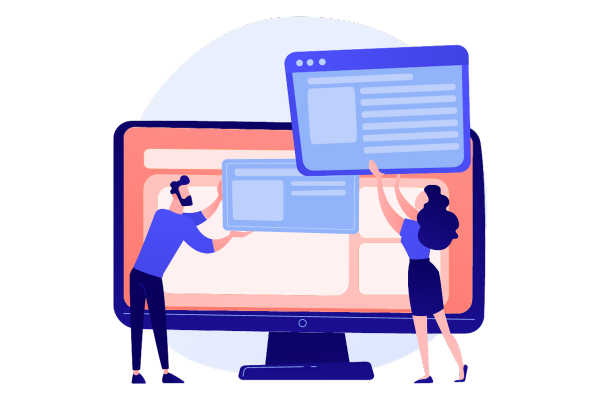
Optimize Landing Pages for Conversion
Landing pages are the critical point where leads convert. Optimizing these pages with persuasive copy, compelling calls to action, and relevant content can significantly increase your lead capture rate. A well-designed landing page should offer a clear value proposition, instill trust, and guide leads toward taking the desired actions.
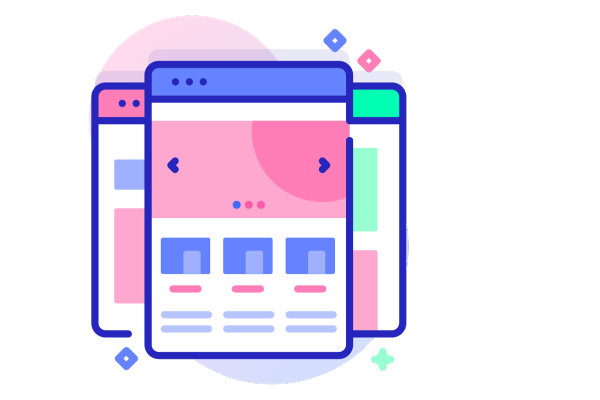
5. Invest in Ads (PPC and Social Ads)
Investing in ads is a strategic move for accelerating lead generation. Paid advertising on platforms like Facebook, LinkedIn, and Google offers a powerful means of reaching a highly targeted audience. Learn how to make the most of your investment by advertising on these platforms.
Facebook’s extensive user base and precise audience targeting make it an excellent platform for lead generation. Indeed, well-crafted Facebook ad campaigns can yield substantial results, helping you connect with potential leads who match your ideal customer profiles.
LinkedIn is the go-to platform for B2B networking. Sponsored content and InMail campaigns allow you to reach professionals in your industry, making it a valuable platform for B2B lead generation.
Related: How to Generate B2B Leads on LinkedIn
Google Ads enable your business to appear at the top of search results. Utilizing pay-per-click (PPC) advertising on Google can capture potential leads who are actively searching for your products or services, delivering highly targeted traffic to your website.
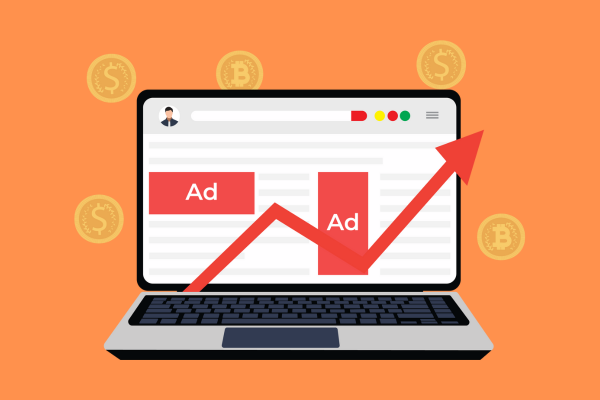
6. Increase Brand Awareness and Trust
We know we touched on this in the content section, but brand awareness isn’t just a byproduct of good content. It deserves its own spotlight.
Building brand awareness is a foundational piece of any strong lead generation strategy. Before a prospect ever becomes a lead, they need to recognize and trust your name. The more familiar your brand feels, the more likely a potential buyer is to engage with you when they’re ready to make a decision.
It’s not just about being seen, it’s about being remembered. Brand awareness creates positive associations, builds credibility over time, and ensures that when a prospect starts comparing options, your business is already top of mind.
Here are some effective ways to boost your brand visibility and reputation:
- Show up consistently across social media and digital platforms
- Leverage paid ads to increase exposure to your target audience
- Participate in industry events, webinars, or podcasts
- Encourage satisfied customers to leave reviews and testimonials
- Use email nurturing and retargeting campaigns to stay present
Ultimately, strong brand awareness helps shorten the sales cycle and warm up leads before your sales team ever picks up the phone.
Encourage Customer Testimonials and Case Studies
Genuine testimonials from satisfied customers provide social proof and build trust. Particularly, sharing positive reviews and testimonials can instill confidence in potential leads, influencing their decision to engage with your business.
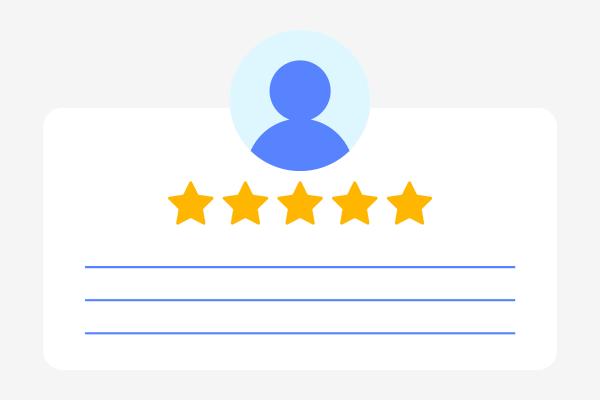
Case studies provide real-world success stories that resonate with potential leads facing similar challenges. They showcase the value of your solutions and how they’ve positively impacted other businesses. Case studies are persuasive tools that can move leads closer to conversion.
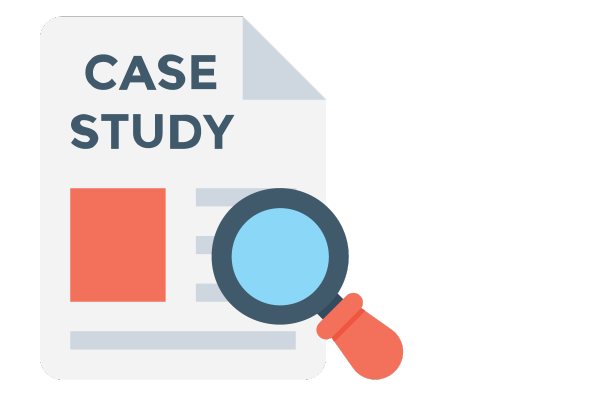
7. Partner with a B2B Online Marketplace
It’s no secret that lead generation isn’t easy. In the competitive B2B landscape, generating high-quality leads can be a time-consuming and challenging process. So, how can you focus on what you do best (running your business), and succeed in generating quality leads? The answer is to partner with a B2B online marketplace.
An online marketplace connects suppliers with high-quality buyers. They help identify and verify potential customers who are likely to convert into paying customers, while you focus on running your business.
Collaborating with an online marketplace presents a unique opportunity for ongoing lead generation. Learn how partnering with an online marketplace can benefit your B2B business.
Gain New Opportunities
A trusted online marketplace is able to regularly introduce new clients to your brand that you might not be able to reach through traditional marketing efforts. This expanded reach creates new opportunities for lead generation and business growth.
Your Leads, Their Work
An online marketplace can connect you with prospects who are actively searching for products and services. They target and verify the leads before making the connection. And at the end of it all, you get to keep the quality lead thanks to their work while you focus on closing.
Increase ROI
By leveraging their existing resources, an online marketplace can lead to significant cost savings compared to traditional lead generation methods. The result is an enhanced return on investment (ROI) and a more efficient approach to acquiring leads. Overall, an online marketplace can help you achieve great close rates and add sales revenue to your bottom line.
Related: What to Expect When You Become a New Lead Partner
8. Optimize for Google’s AI Overview (AEO)
Google’s AI Overview is rewriting the rules of SEO. Instead of waiting for users to click, AEO surfaces direct answers at the very top of search results. While this means fewer clicks, it also creates a massive opportunity to get your brand in front of buyers earlier in the journey.
Here’s how to optimize for AEO and keep your lead flow strong:
- Answer questions directly. Use headers and clear language to match buyer search intent.
- Provide structured content. Tables, bullet points, and concise definitions increase your chances of being pulled into AEO.
- Add visuals and data. Google favors content that enhances user understanding, like charts, pricing breakdowns, or comparisons, which can give you an edge.
- Focus on buyer pain points. AEO rewards pages that provide actionable, trustworthy solutions.
If you play the game right, even if prospects don’t click, your brand becomes the authority they recognize. This is the first step to building trust and generating leads.
9. Host Interactive Webinars and Virtual Events
Webinars aren’t new, but in 2026, interactivity is what separates the average from the effective. B2B buyers don’t just want a lecture; they want engagement, real-time answers, and insights they can apply immediately.
Here’s how to make webinars and virtual events a reliable lead generation engine:
- Pick a timely, niche topic. Solve a pressing pain point, not just a broad industry theme.
- Add interactive elements. Polls, live Q&A, and breakout sessions increase participation.
- Offer a valuable takeaway. A checklist, worksheet, or slide deck keeps your brand in front of attendees long after the event.
- Follow up fast. Don’t let leads cool off. Send a recap email within 24 hours and pass engaged attendees to sales.
Well-executed webinars build credibility, expand your reach, and attract decision-makers who are already invested in your expertise.
10. Use Account-Based Marketing (ABM) to Target High-Value Leads
Not all leads are created equal, and in 2026, businesses can’t afford to waste time chasing every prospect. Account-Based Marketing (ABM) flips the funnel by targeting specific, high-value accounts with personalized campaigns designed to convert.
Here’s how ABM fuels lead generation:
- Define your target accounts. Work with sales to identify companies that align with your ideal customer profile.
- Create personalized content. Build custom landing pages, tailored outreach, or even account-specific case studies.
- Leverage multi-channel campaigns. Combine email, LinkedIn, direct mail, and retargeting ads for consistent messaging.
- Measure engagement by account. Focus on quality interactions over raw lead numbers.
ABM allows you to put your resources where they matter most, on the accounts most likely to generate revenue and long-term partnerships.
Final Thoughts on B2B Lead Generation Strategies in 2026
To conclude, B2B lead generation strategies aren’t just nice to have, they’re essential tools that shape your path toward success. In a landscape where every lead counts, these seven strategies will be your key to achieving your goals.
Ready to take your lead generation to the next level? Transform your business by joining 360Connect, a top lead generation company that delivers high-quality leads daily.
Become a 360Connect supplier and unlock a world of opportunities.

